















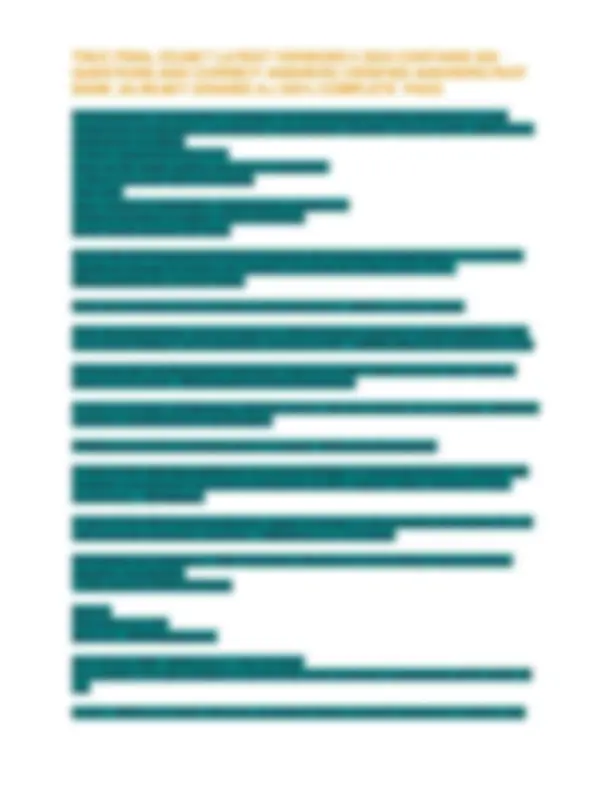

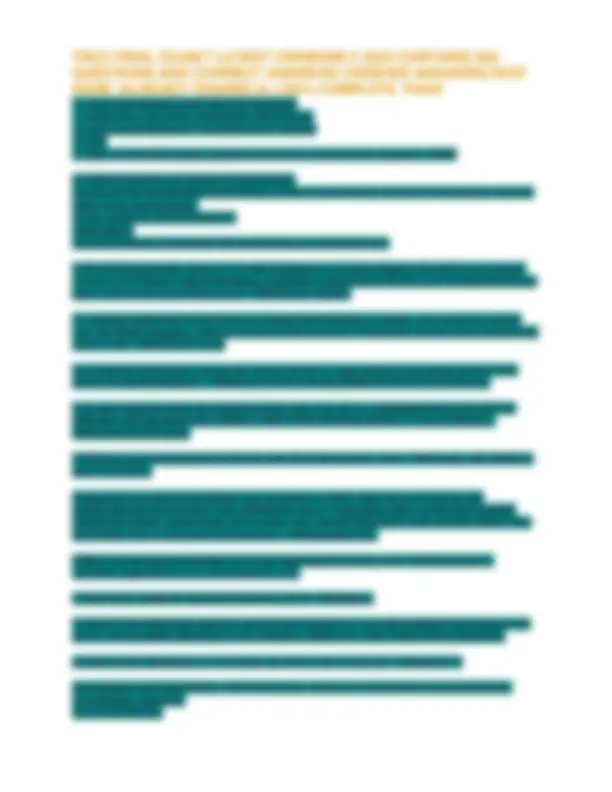







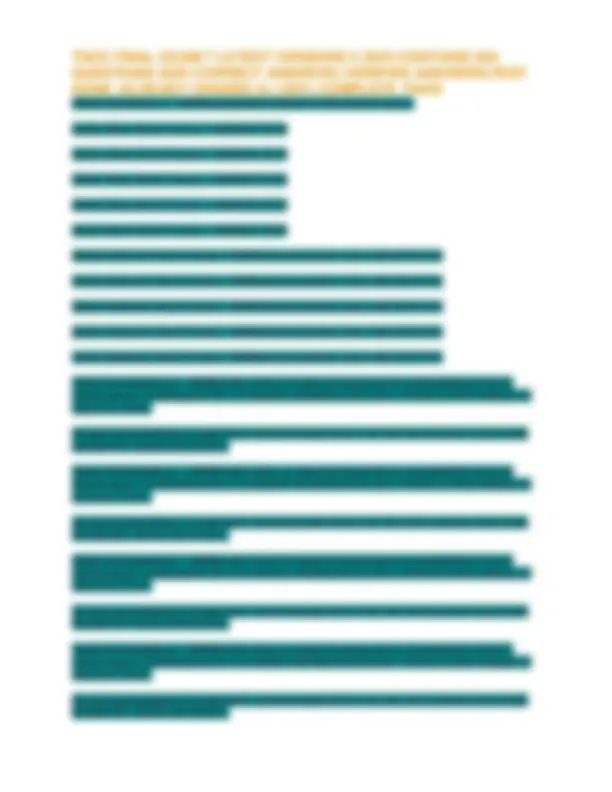
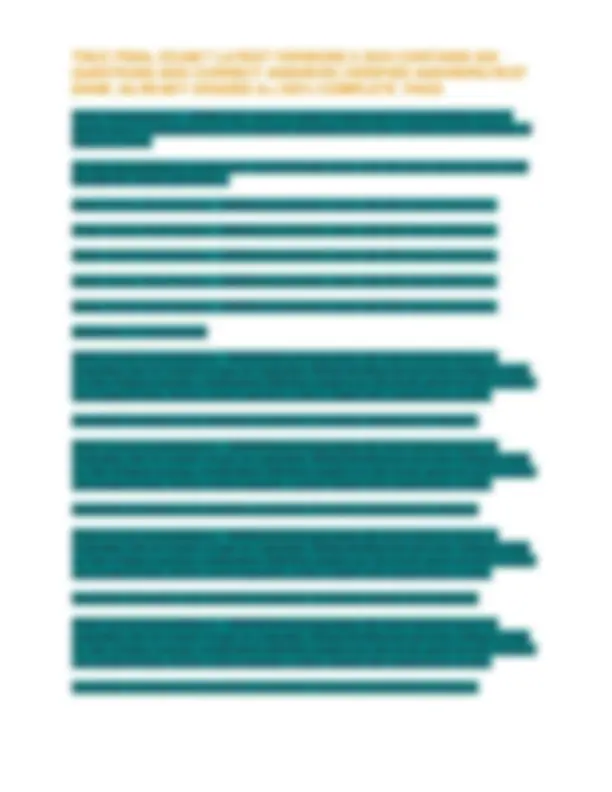



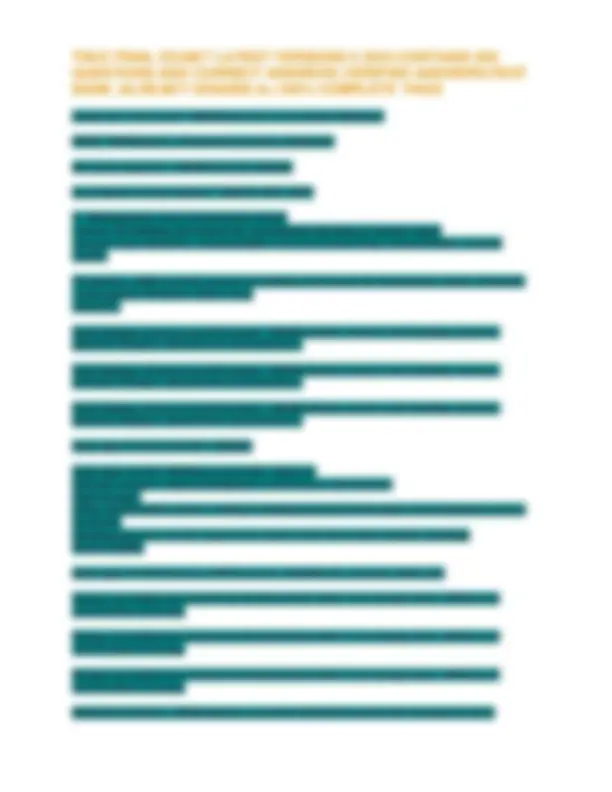



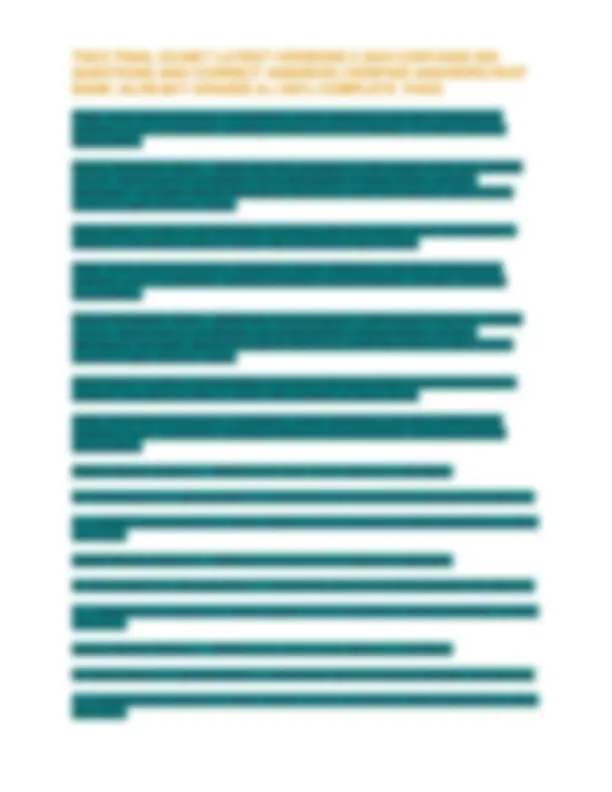


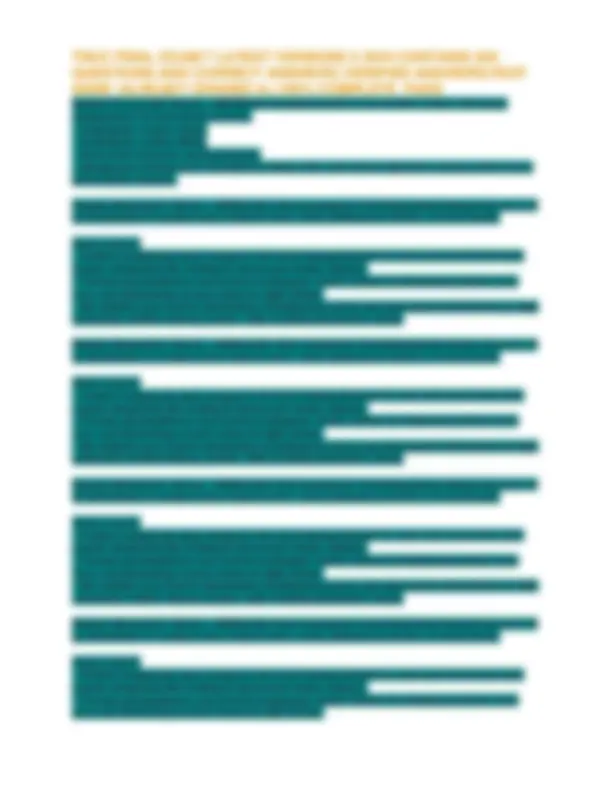
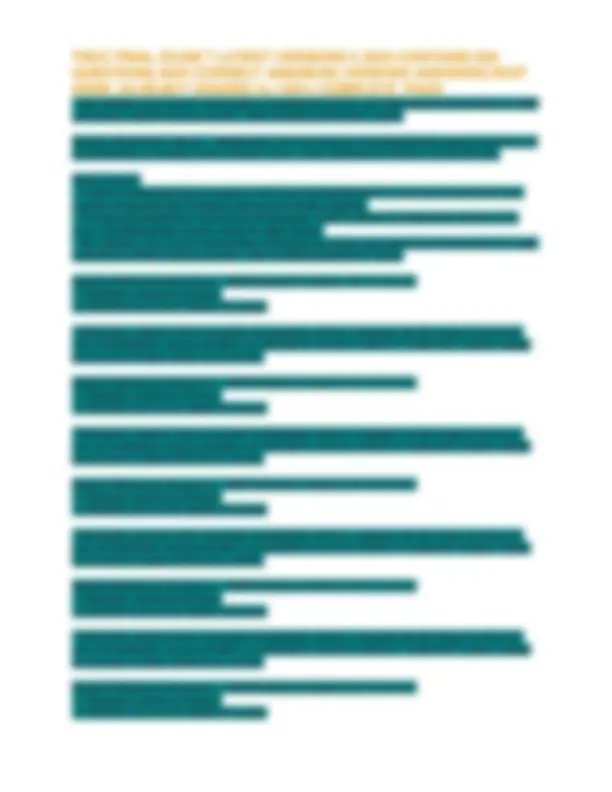


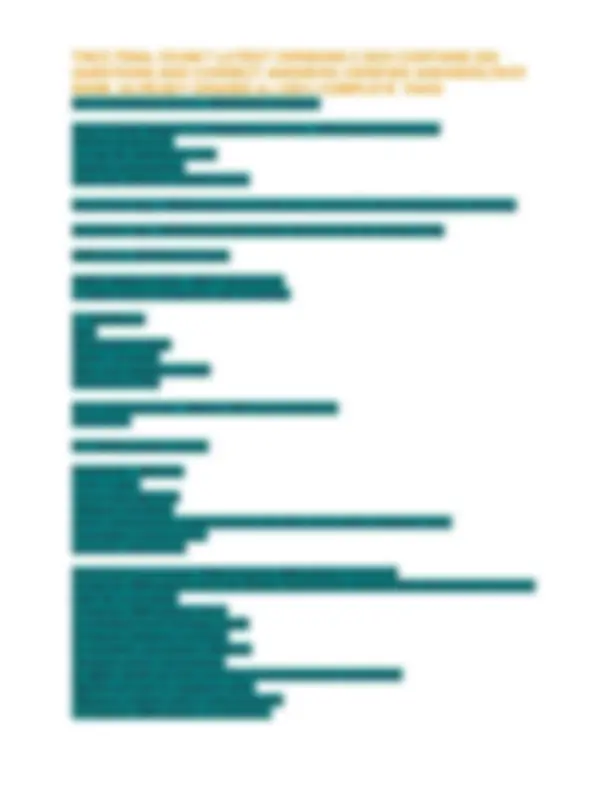


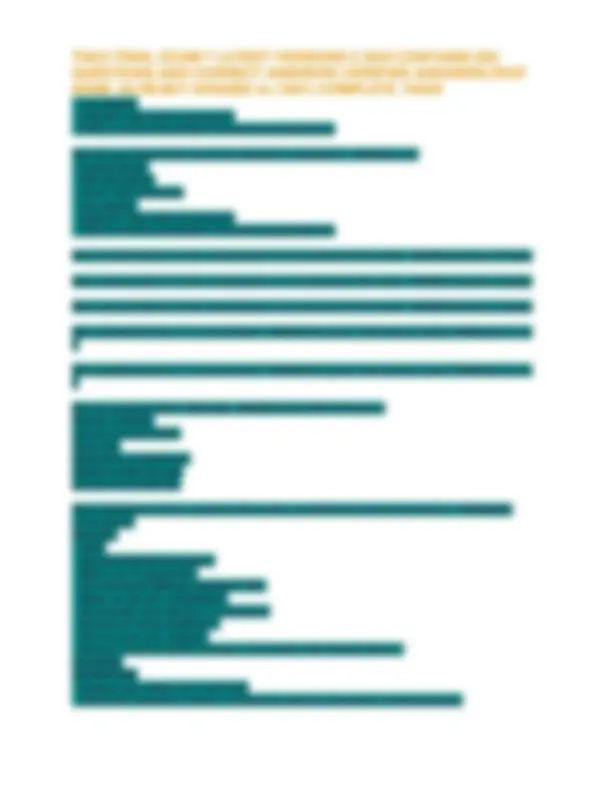
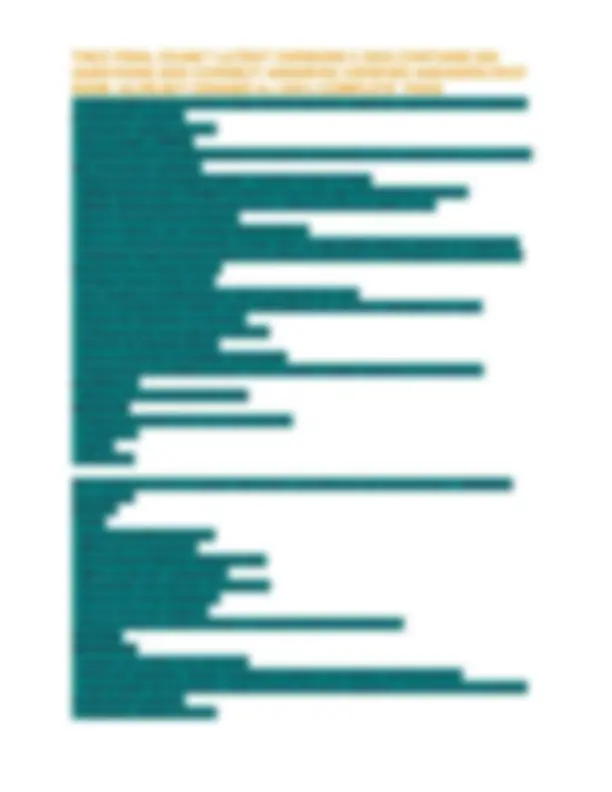


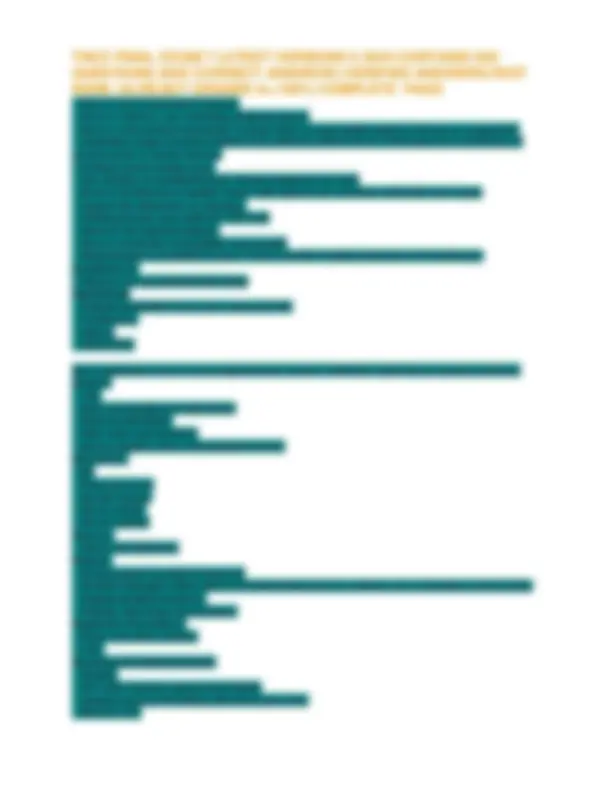
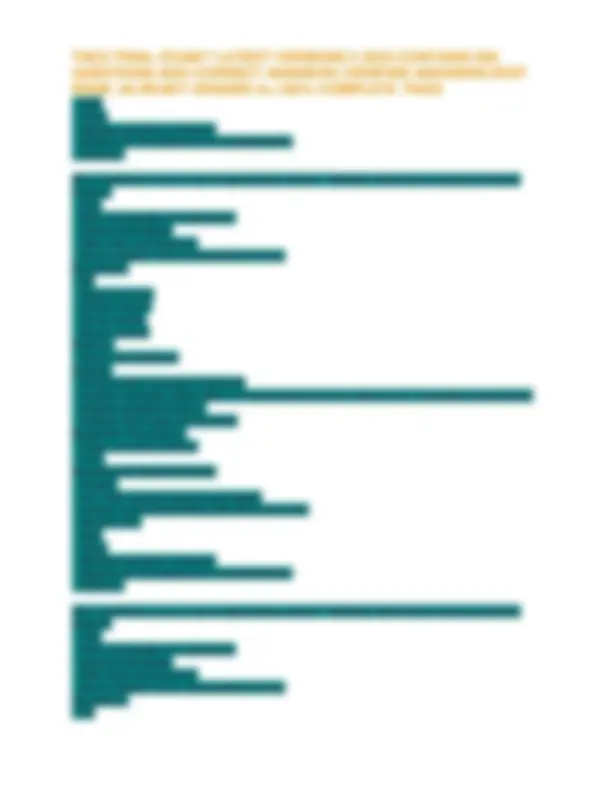



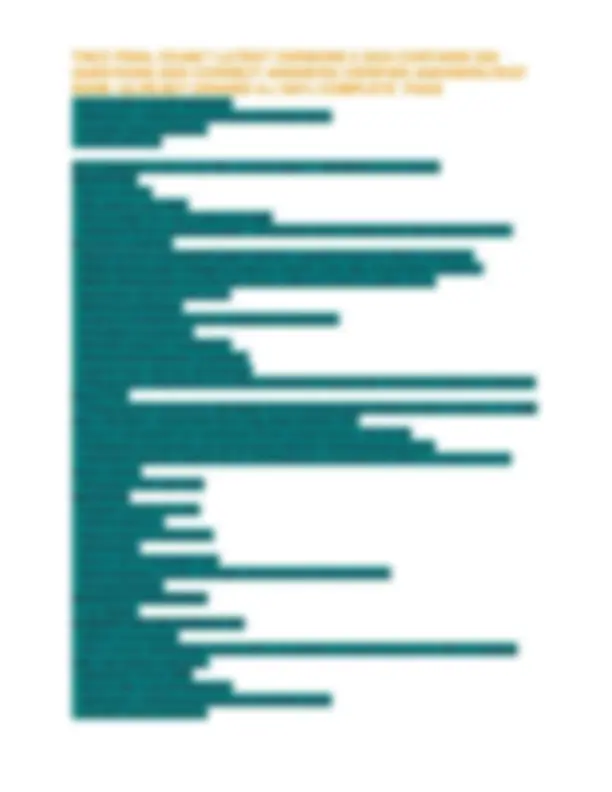

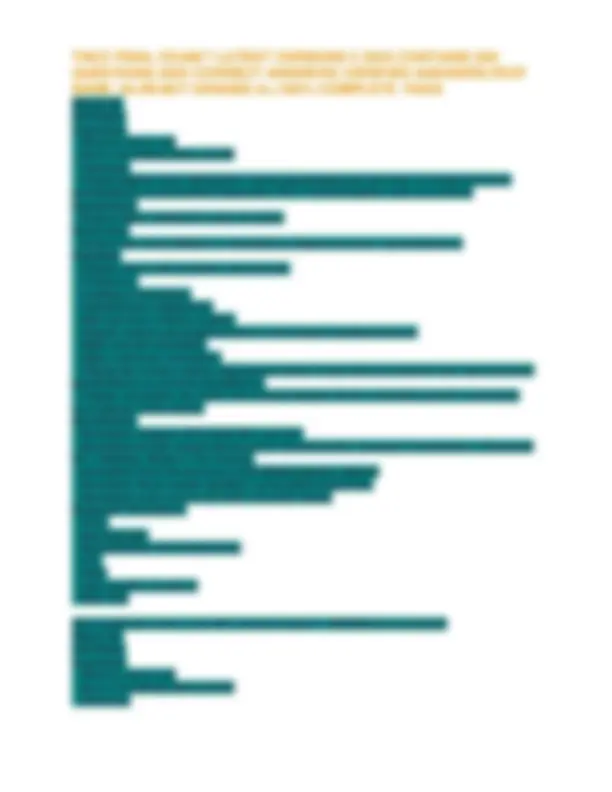


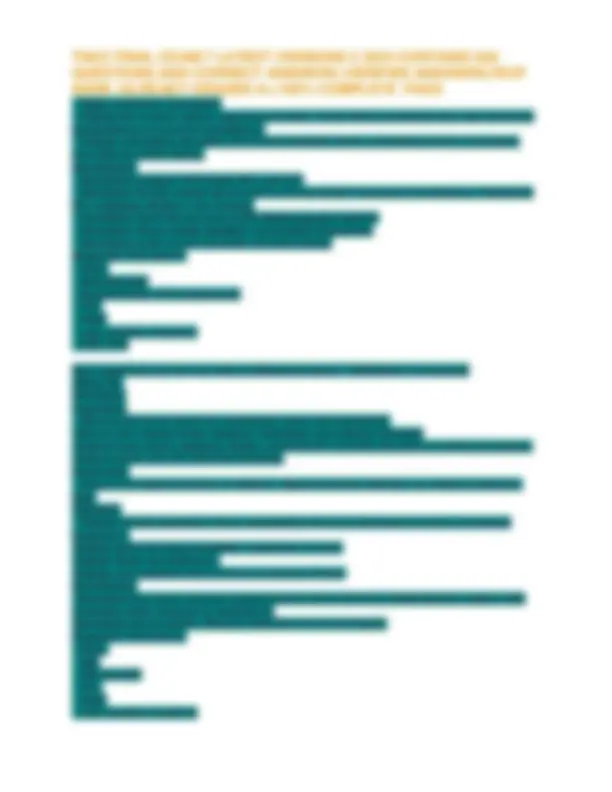

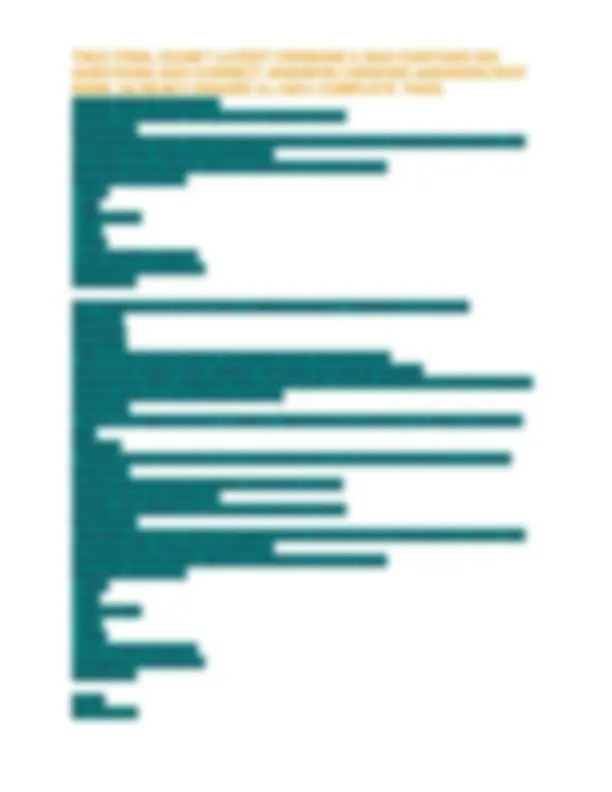

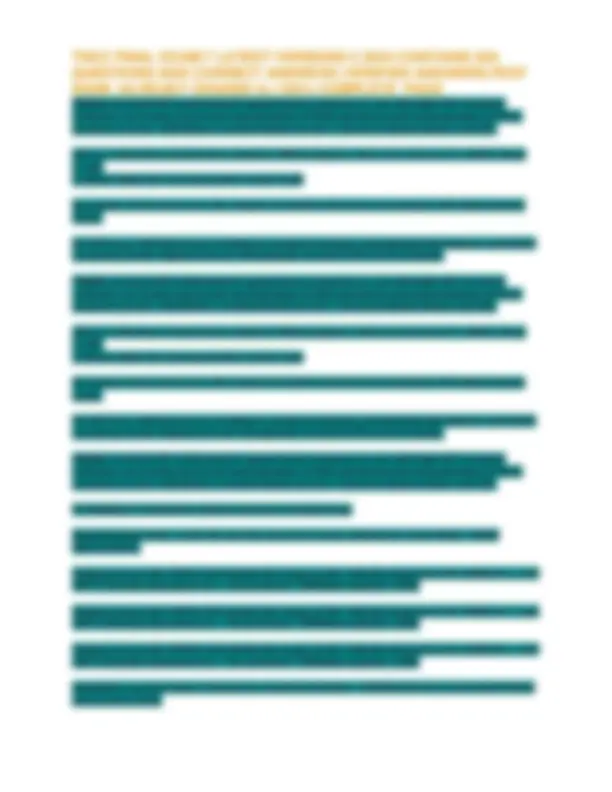










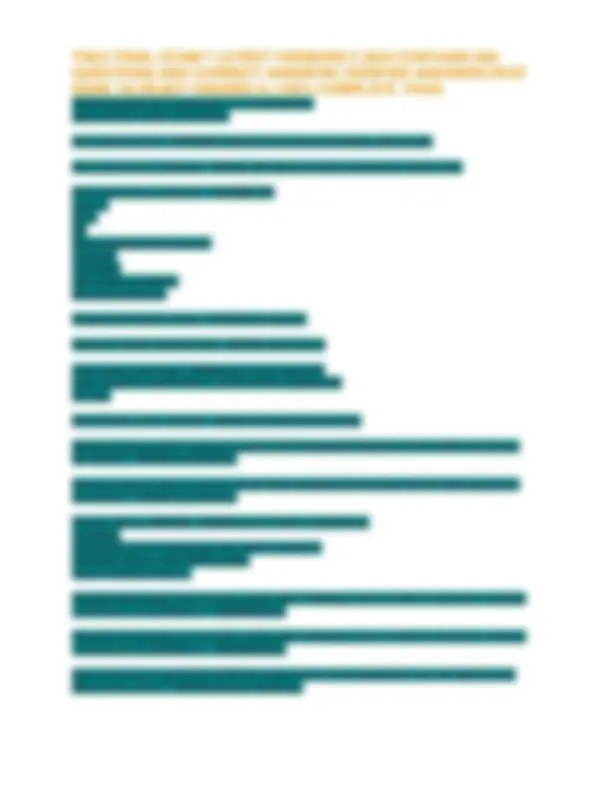


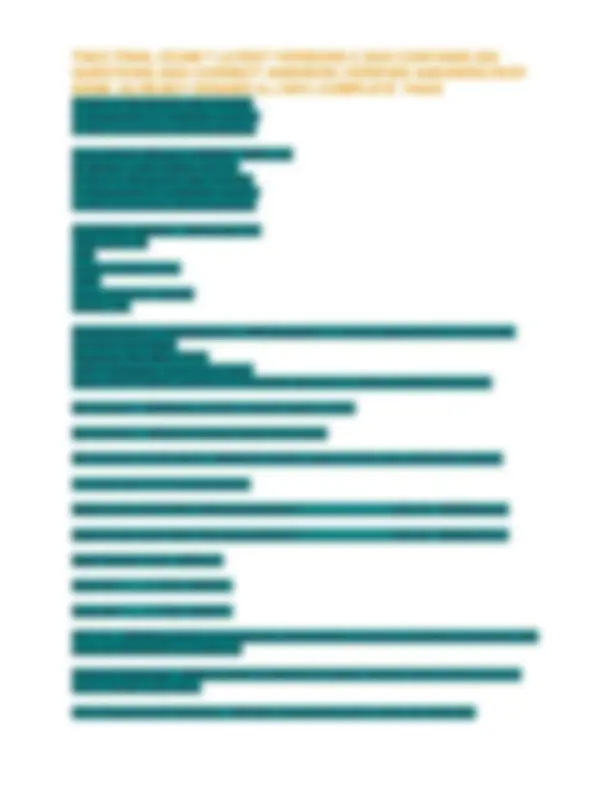

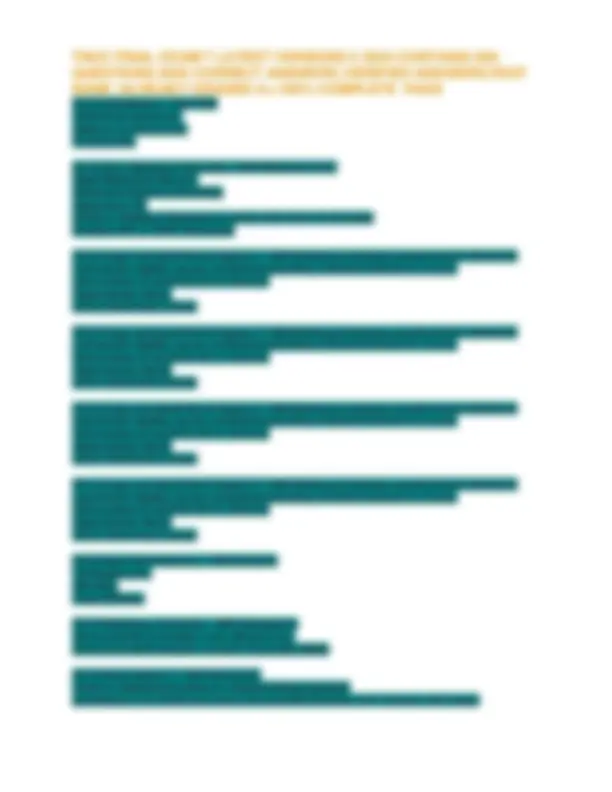


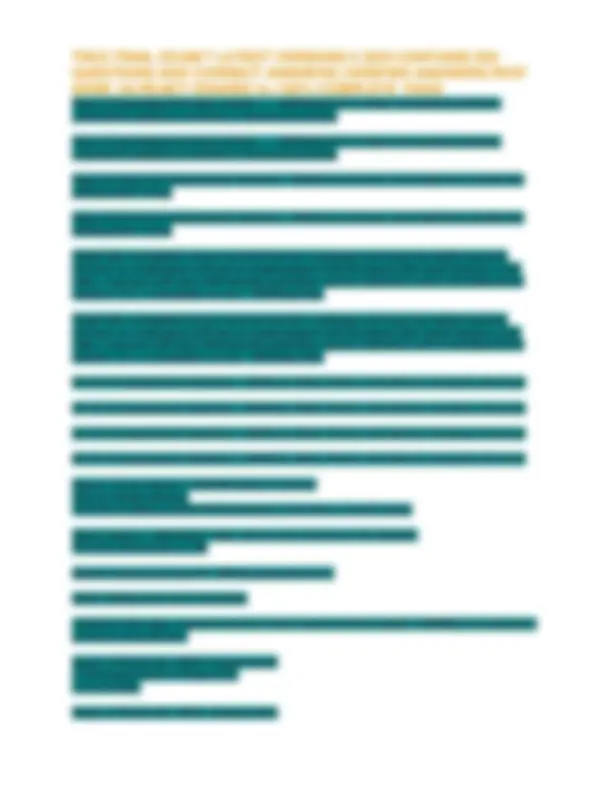





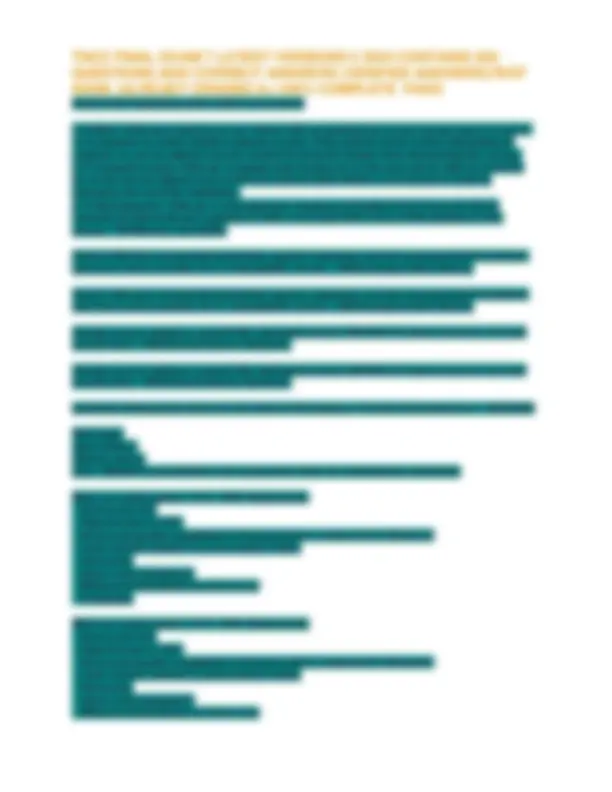

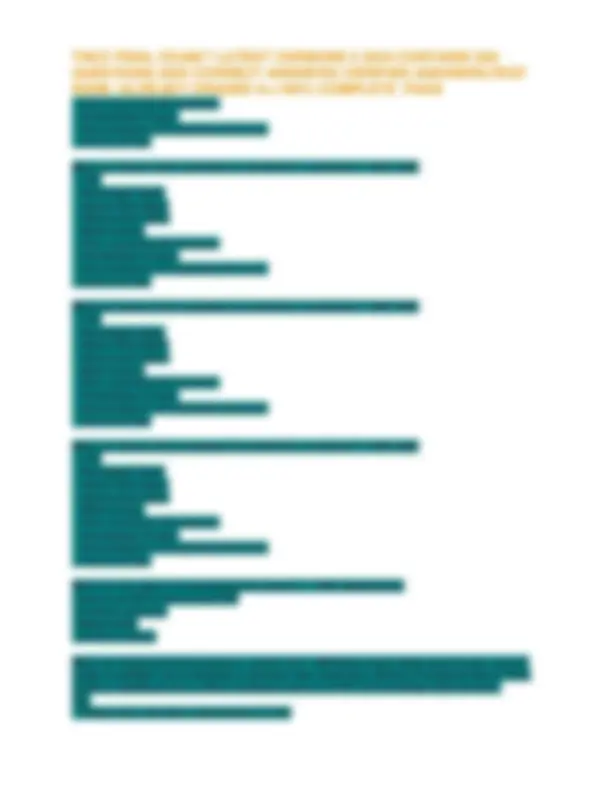




Study with the several resources on Docsity

Earn points by helping other students or get them with a premium plan


Prepare for your exams
Study with the several resources on Docsity

Earn points to download
Earn points by helping other students or get them with a premium plan
Community
Ask the community for help and clear up your study doubts
Discover the best universities in your country according to Docsity users
Free resources
Download our free guides on studying techniques, anxiety management strategies, and thesis advice from Docsity tutors
A comprehensive set of multiple choice questions and answers covering key concepts in trauma nursing, including primary and secondary surveys, shock management, and specific injury types. it's valuable for students preparing for the tncc exam or reinforcing their understanding of trauma care principles. The questions assess knowledge of airway management, breathing and ventilation, circulation and hemorrhage control, disability (neurological status), and exposure/environmental control. the answers are provided, allowing for self-assessment and learning.
Typology: Exams
1 / 175

This page cannot be seen from the preview
Don't miss anything!





























































































Which of the following is true about the log roll maneuver? A) it causes less spinal motion than the lift and slide maneuver B) it is recommended for patients with unstable pelvic fractures C) it can worsen cord damage from an unstable spinal injury *** D) it does not increases the risk of life threatening hemorrhage from unstable injuries - ANSC) it can worsen cord damage from an unstable spinal injury Which of the following mnemonics can help the nurse prioritize care for a trauma patient with massive uncontrolled hemorrhage? A) ABC B) MARCH C) AVPU D) VIPP - ANSB) MARCH Which of the following occurs during the third impact of a motor vehicle crash? A) The driver of the vehicle collides with the steering wheel B) the vehicle collides with a tree C) the aorta is torn at its attachment with the ligamentum arteriosum D) the airbag deploys and strikes the front seat passenger - ANSC) the aorta is torn at its attachment with the ligamentum arteriosum Which of the following patients warrants referral to a burn center? A) a 21- year old female with a partial thickness burn to the right forearm B) a 40-year old hypertensive male with a superficial burn to the back C) a 52-year old diabetic male with partial thickness burn to the left lower leg D) a 35-year old hyperlipidemic female with superficial burns to the anterior thorax. - ANSC) a 52 - year old diabetic male with partial thickness burn to the left lower leg Which of the following values indicates the need for alcohol withdrawal interventions? A) CIWA-Ar of 36 *** B) GCS 13 C) ETCo2 of 48 mm Hg D) heart rate of 45 beats/min - ANSA) CIWA-Ar of 36 Which pulse pressure description is an indication of early hypovolemic shock? A) widened B) narrowed C) bounding D) weak - ANSB) narrowed Why is a measure of serum lactate obtained in the initial assessment of the trauma patient?
a) to measure oxygenation and ventilation b) to quantify the base deficit for the adequacy of cellular perfusion c) to gauge end-organ perfusion and tissue hypoxia d) to determine the underlying cause of shock - ANSc) to gauge end-organ perfusion and tissue hypoxia You are caring for a patient who was involved in a MVA and is 32 weeks pregnant. Findings of your secondary survey include abd pain on palpation, fundal high at the costal margin, and some dark bloody show. Varying, accelerations and decelerations are noted on the cardiotocography. These findings are most consistent with which of the following? A) placental abruption B) preterm labor C) uterine rupture D) fetal demise - ANSA) placental abruption You are treating a 27-year old male in respiratory distress who was involved in a house fire. Calculating TBSA burned is deferred d/t the need for emergent intubation. At what rate should you begin fluid resuscitation? A) 1000 mL/hr B) 500 mL/hr C) 250 mL/hr D) 125 mL/hr - ANSB) 500 mL/hr A (AVPU) - ANSAlert. Will be able to maintain airway once clear. A (Primary Survey) - ANSAirway and alertness with simultaneous cervical spinal stabilization. Airway Assessment - ANSInspect: tongue obstruction, loose/missing teeth, foreign objects, blood, vomitus, secretions, edema, burns or evidence of inhalation injury Auscultate: listen for obstructive airway sounds (ie. snoring, gurgling, stridor) Palpate: palpate for possible occlusive maxillofacial bony deformity, subcutaneous emphysema Airway Interventions: - ANSSuction Remove foreign body if noted Jaw thrust maneuver (maintain cspine) Nasopharyngeal airway (can be conscious) Oropharyngeal airway (no gag) Consider definitive airway Alertness Assessment - ANSA-Alert V-Verbal P-Painful U-Unresponsive B (Primary Survey) - ANSBreathing and Ventilation
Initiate IVF of warmed isotonic crystalloid solution. Consider blood products after 2L. **Large volumes of fluid lead to dilution coagulopathy which worsens metabolic acidosis and may cause hypothermia. Component therapy, including administering RBC, plasma and platelets is a balanced approach so that O2 delivery is optimized, acidosis corrected and coagulopathy prevented. Classifications of Shock - ANSHypovolemic - decrease in the amount of circulating blood volume Obstructive - obstruction in either the vasculature or heart Cardiogenic - pump failure in the presence of adequate intravascular volume Distributive - maldistribution of an adequate circulating blood volume (septic, anaphylactic, neurogenic) Corneal Abrasion - ANSDamage to the corneal epithelium. Easy to evaluate with fluorescein. Findings: photophobia, tearing, pain, injected conjunctiva (redness), lid swelling, irritation Treatment: Ophthalmic ABX, Cycloplegic agent to decrease spasms and pain, ophthalmic NSAIDS to decrease swelling, oral analgesics, Ophthalmic f/u in 24 hours. (Do NOT patch - increases infection) Corneal Foreign Body - ANSRoutinely metal, plastic or wood. Findings: photophobia, pain, injected conjunctiva (redness), lid swelling Treatment: topical anesthetic, removal of foreign body, ophthalmic ABX, cycloplegics, oral analgesia Corneal Laceration - ANSInvolves one or more layers of the cornea. Visualized with a slit lamp. Findings: similar to abrasion, pain out of proportion to findings, decreased vision Treatment: treat small lacerations similar to an abrasion, larger lacerations need ophthalmology referral and possible surgery Cycloplegic agent - ANSCycloplegia is paralysis of the ciliary muscle of the eye, resulting in a loss of accommodation. Because of the paralysis of the ciliary muscle, the curvature of the lens can no longer be adjusted to focus on nearby objects. D (Primary Survey) - ANSDisability (Neurologic Status) Disability Assessment - ANSAssess GCS on arrival and repeat per policy. Assess pupils for equality, shape and reactivity (PERRL)
Disability interventions - ANSEvaluate for need for CT. Assume AMS to be the result of CNS injury until proven otherwise. Consider ABGs - AMS may be indicator of decreased cerebral perfusion, hypoventilation or acid-base imbalance. Consider bedside glucose. Distributive Shock - ANSOccurs as a result of maldistribution of an adequate circulating volume with a loss of vascular tone or increased permeability. Diffuse vasodilation lowers the systemic pressure, creating a relative hypovolemia or reduction of the mean systemic volume and venous return to the heart or drop in preload, resulting in distributive shock. Anaphylactic: release of inflammatory mediators, such as histamine, which contracts bronchial smooth muscle and increases vascular permeability and vasodilation. Septic Shock: systemic release of bacterial endotoxins, resulting in an increased vascular permeability and vasodilation Neurogenic shock: loss of sympathetic nervous system control of vascular tone, which produces venous and arterial vasodilation. With the loss of sympathetic nervous system input in spinal cord injury, unopposed vagal activity may result in decreased cardiac output through bradycardia. TREATMENT: increase systemic resistance, controlled volume replacement. Vasoconstriction and in some cases (neurogenic) Atropine to counteract bradycardia. E (Primary Survey) - ANSExposure and Environmental Control Exposure and Environmental Control - ANSCarefully and completely undress the patient. Inspect for uncontrolled bleeding and note any obvious injuries. Prevent heat loss. Hypothermia combined with hypotension and acidosis is a potentially lethal combination in the injured patient. Consider: warm blankets, keep ambient temperature warm, warm IVF, forced air warmers, radiant warming lights. F (Primary Survey) - ANSFull Set of VS & Family Presence G (Primary Survey) - ANSGet Resuscitation Adjuncts: (LMNOP) L: Labs M: Monitor cardiac rate and rhythm N: Naso or orogastric tube consideration O: Oxygenation - SpO2 and/or etCO2 monitor P: Pain assessment and management
Palpate: depressions, angulations, tenderness Hepatic Injuries - ANSIn blunt trauma the liver may lacerate from increased abdominal pressure. Hematoma - bleeding contained within the capsule Laceration - the capsule is disrupted Findings: Cullen sign (ecchymosis around the umbilicus or RUQ), tenderness, guarding or rigidity RUQ, 9-12 rib FXs, elevated LFT Graded I-VI, I = minor trauma Nonoperative management is standard of care in hemodynamically stable patient. Observed with serial abdominal exams. Findings of contrast extravasation may be embolized by IR. For surgical patients - fluid resuscitation is essential. Risks of surgery include disruption of the natural tamponade process due to the evacuation of large amounts of blood resulting in hypovolemia. Hypovolemic Shock - ANSCaused by a decrease in the amount of circulating blood volume. In trauma typically results from hemorrhage, but can result in a precipitous loss of volume, ie vomiting or diarrhea. Burn trauma can result in hypovolemic shock from damage to the cell membranes leading to plasma and protein leakage. of body water, results in inadequate perfusion. Hyperventilation can cause increased intrathoracic pressure resulting in compression of the heart and decreased cardiac output. Initial Assessment - ANS1. Preparation and Triage
Treatment: elevate HOB, ophthalmology, immobilize foreign body, patch UNAFFECTED eye to limit concomitant eye movement, globe closure ASAP, systemic and ophthalmic ABX, analgesics. Postop infection, retinal detachment and vision loss are common complications. lid injury - ANS Liver - ANSLargest solid organ of the body. RUQ, 6th to 10th ribs. Encased by Glisson capsule with blood vessels, lymphatics and nerves. Filters 1.7L of blood per minute. The liver filters out toxins, takes the nutrients and returns the blood to the heart via the hepatic veins. Hepatocyte cells are capable of regeneration allowing the liver to repair its own tissue. Functions: Store and metabolize lipids, transport nutrients, produce glucose and bilirubin, convert ammonia to urea, secrete electrolytes, lipids, lecithin, cholesterol and bile. Metabolizes vitamin K and produces thrombin and fibrinogen (all necessary for clotting). Obstructive Shock - ANSResults from hypo perfusion of the tissue due to an obstruction in either the vasculature or heart. Tension pneumothorax - increased thoracic pressure leads to displacement of the vena cava, obstruction to atrial filling, decreased preload and decreased cardiac output. Cardiac tamponade - impedes diastolic expansion and filling leads to decreased preload, strokes volume and cardiac output and ultimately end organ perfusion. P (AVPU) - ANSPainful. Responds only to painful stimuli. (Airway adjunct may be needed while determining need for intubation) Reevaluation - ANSPortable radiograph - AP chest, pelvis. Can quickly identify potentially life- threatening injuries such as pneumothorax or pelvic fracture with uncontrolled internal hemorrhage. Can also confirm placement of ET tubes, chest tubes and gastric tubes. Consider need for transfer. shock - ANSInadequate tissue perfusion. Spleen - ANSEncapsulated organ LUQ level of 9th-11th ribs and curves around a portion of the stomach. Minimal elasticity and flexibility - most frequent injured organ in blunt trauma. Secondary lymph organ that filters and cleanses the blood. Removes old RBCs and holds a reserve of blood. It recycles iron. It removes antibody-coated bacteria. Supplies lymphocytes to stimulate an immune response to blood borne microorganisms. Stores 200-300ml of blood and leads to hemodynamic instability quickly if damaged.
__________________ Shock: Spinal cord injury at T6 or above. Temporary loss of vasomotor tone and sympathetic innervation. Temporary duration usually <72 hours. S & S: hypotension, bradycardia, loss of ability to sweat below level of injury. - ANSNeurogenic ___________________: Impairs thrombin production and platelet function _____________ ______________: Impairs thrombin production _______________________: Results in depletion of clotting factors through hemodilution and the impaired ability to produce clotting factors. - ANSTrauma Triad of Death
... is a test that requires fluid to be sent to the lab and is considered the gold standard for identifying CSF - ANSBeta2-Transferrin ... is a triad of assessment findings; widening pulse pressure, bradycardia, and diminished respiratory effort - ANSCushing ( it is an attempt to increase MAP against elevated ICP, ultimately trying to cause a rise in CPP) ... is a triad of assessment findings; widening pulse pressure, bradycardia, and diminished respiratory effort - ANSCushing ( it is an attempt to increase MAP against elevated ICP, ultimately trying to cause a rise in CPP) ... is a triad of assessment findings; widening pulse pressure, bradycardia, and diminished respiratory effort - ANSCushing ( it is an attempt to increase MAP against elevated ICP, ultimately trying to cause a rise in CPP) ... is damaged brain tissue usually caused by blunt trauma - ANSCerebral contusion ... is damaged brain tissue usually caused by blunt trauma - ANSCerebral contusion ... is damaged brain tissue usually caused by blunt trauma - ANSCerebral contusion ... is defined as the pressure gradient across the brain tissue, or the difference between the pressures of the cerebral artery and venous vessels. - ANSCPP; CPP = map - icp ... is defined as the pressure gradient across the brain tissue, or the difference between the pressures of the cerebral artery and venous vessels. - ANSCPP; CPP = map - icp ... is defined as the pressure gradient across the brain tissue, or the difference between the pressures of the cerebral artery and venous vessels. - ANSCPP; CPP = map - icp ... is the initial post traumatic inflammatory response. ... ... activates this response and ... are sent to the injury sites, activating signaling pathways that mobilize inflammatory cells. - ANSImmune response; tissue hypoxia;neutrophils ... is the initial post traumatic inflammatory response. ... ... activates this response and ... are sent to the injury sites, activating signaling pathways that mobilize inflammatory cells. - ANSImmune response; tissue hypoxia;neutrophils ... is the initial post traumatic inflammatory response. ... ... activates this response and ... are sent to the injury sites, activating signaling pathways that mobilize inflammatory cells. - ANSImmune response; tissue hypoxia;neutrophils ... is the shifting of brain tissue with displacement into another compartment as the result of bleeding or edema. - ANSHerniation ... is the shifting of brain tissue with displacement into another compartment as the result of bleeding or edema. - ANSHerniation
... shock is from hemorrhage and is the leading cause of preventable deaths in trauma patients. Can also be caused by plasma loss in ... - ANSHypovolemic; burns ... shock occurs as a result of maldistribution of an adequate circulation blood volume with the loss of vascular tone or increased permeability. 3 examples. - ANSDistributive; anaphylactic, septic and neurogenic ... shock occurs as a result of maldistribution of an adequate circulation blood volume with the loss of vascular tone or increased permeability. 3 examples. - ANSDistributive; anaphylactic, septic and neurogenic ... shock occurs as a result of maldistribution of an adequate circulation blood volume with the loss of vascular tone or increased permeability. 3 examples. - ANSDistributive; anaphylactic, septic and neurogenic ... shock results from hypoperfusion of the tissue due to an obstruction in either the vasculature or heart. Two examples include.... - ANSObstructive;tension pneumothorax, cardiac tamponade. (With tension pneumo the increase in intrathoracic pressure leads to displacement of the vena cava, obstruction to arrival filling leading to decreased preload and decreased cardiac output) ( with cardiac tamponade there is an accumulation of fluid in the pericardial sac impeding diastolic expansion and filling leading to decreased preload, stroke volume,CO and end organ perfusion) ... shock results from hypoperfusion of the tissue due to an obstruction in either the vasculature or heart. Two examples include.... - ANSObstructive;tension pneumothorax, cardiac tamponade. (With tension pneumo the increase in intrathoracic pressure leads to displacement of the vena cava, obstruction to arrival filling leading to decreased preload and decreased cardiac output) ( with cardiac tamponade there is an accumulation of fluid in the pericardial sac impeding diastolic expansion and filling leading to decreased preload, stroke volume,CO and end organ perfusion) ... shock results from hypoperfusion of the tissue due to an obstruction in either the vasculature or heart. Two examples include.... - ANSObstructive;tension pneumothorax, cardiac tamponade. (With tension pneumo the increase in intrathoracic pressure leads to displacement of the vena cava, obstruction to arrival filling leading to decreased preload and decreased cardiac output) ( with cardiac tamponade there is an accumulation of fluid in the pericardial sac impeding diastolic expansion and filling leading to decreased preload, stroke volume,CO and end organ perfusion) .... activation: .... are found in the carotid sinus and along the aortic arch, are sensitive to the degree of stretch in the arterial wall. When the receptors sense a decrease in stretch, they stimulate the sympathetic nervous system to release Epi, norepi, causing stimulation of cardiac activity and constriction of blood vessels, which causes a rise in heart rate and diastolic blood pressure - ANSBaroreceptor activation; baroreceptors .... activation: .... are found in the carotid sinus and along the aortic arch, are sensitive to the degree of stretch in the arterial wall. When the receptors sense a decrease in stretch, they stimulate the sympathetic nervous system to release Epi, norepi, causing stimulation of
cardiac activity and constriction of blood vessels, which causes a rise in heart rate and diastolic blood pressure - ANSBaroreceptor activation; baroreceptors .... activation: .... are found in the carotid sinus and along the aortic arch, are sensitive to the degree of stretch in the arterial wall. When the receptors sense a decrease in stretch, they stimulate the sympathetic nervous system to release Epi, norepi, causing stimulation of cardiac activity and constriction of blood vessels, which causes a rise in heart rate and diastolic blood pressure - ANSBaroreceptor activation; baroreceptors .... are frequently associated with minor injury in older adults, patients taking anticoagulation medications and patients with chronic alcohol abuse. - ANSChronic subdural Hematoma .... are frequently associated with minor injury in older adults, patients taking anticoagulation medications and patients with chronic alcohol abuse. - ANSChronic subdural Hematoma .... are frequently associated with minor injury in older adults, patients taking anticoagulation medications and patients with chronic alcohol abuse. - ANSChronic subdural Hematoma .... can produce bleeding that may not be evident until several hours after injury - ANSBasilar skull fractures .... can produce bleeding that may not be evident until several hours after injury - ANSBasilar skull fractures .... can produce bleeding that may not be evident until several hours after injury - ANSBasilar skull fractures .... is suspected in any patient with multi system trauma. - ANSCervical spine injury .... is suspected in any patient with multi system trauma. - ANSCervical spine injury .... is suspected in any patient with multi system trauma. - ANSCervical spine injury .... is the major cause of preventable death after injury - ANSUncontrolled hemorrhage .... is the major cause of preventable death after injury - ANSUncontrolled hemorrhage .... is the major cause of preventable death after injury - ANSUncontrolled hemorrhage .... is the study of energy transfer as it applies to identifying actual or potential injuries - ANSKinematics .... is the study of energy transfer as it applies to identifying actual or potential injuries - ANSKinematics
Maxillary fractures
Evidence of inhalation injury (facial burns)
Laryngeal or tracheal injury or neck hematoma
High risk of aspiration and patients inability to protect the airway
Compromised or ineffective ventilation - ANSFollowing conditions might require a definitive airway
bony fractures and possible rib fractures, which may impact ventilation
palpate for crepitus
subcutaneous emphysema which may be a sign for a pneumothorax
soft tissue injury - ANSPalpate the chest for
Check the presence of adequate rise and fall of the chest with assisted ventilation
Absence of gurgling on auscultation over the epigastrium
Bilateral breath sounds present on auscultation
Presence of carbon dioxide (CO2) verified by a CO2 device or monitor - ANSIf the pt has a definitive airway in what should you do?
Dyspnea
Tachycardia
Decreased or absent breath sounds on the injured side
CP - ANSSimple Pneumo assessment:
equal breath sounds bilaterally at the second intercostal space midclavicular line and the bases for fifth intercostal space at the axillary line - ANSAuscultate the chest for:
Get a CT
Consider ABG 's if decreased LOC
Consider glucose check - ANSD Interventions
Hypotension
JVD
Muffled heart sounds - ANSBecks Triad:
open the airway, use jaw thrust
insert an oral airway
assist ventilations with a bag mask
prepare for definitive airway - ANSIf breathing is absent..
pain - hallmark sign, early sign
pressure - early sign
pallor, pules, paresthesia, paralysis - late sign - ANSSix P's of compartment syndrome:
Preparation
Preoxygenation
Pretreatment
Paralysis and Induction
Protecting and positioning - v
Placement of proof - secure the tube
A a pt sustrained a penetrating injury of his upper leg. the pre hospital personnel states a large amount of blood loss before hemostasiswas achieved. he presents to the ER responding to painful stimuli with moaning. he is tachy 142 b/p 104/96 and RR 24 - ANSdecompensated A an unrestrained driver was involved in a frontal collision without airbag deployment. he is hypotensive and tachycardic with shallow respirations, distended JVD and muffled heart tones the nurse prepare for what - ANSpericardiocentesis A body at rest will remain at rest, a body in motion will stay in motion - ANSNewton's first law A body at rest will remain at rest, a body in motion will stay in motion - ANSNewton's first law A body at rest will remain at rest, a body in motion will stay in motion - ANSNewton's first law A breath every 5 to 6 seconds: 10-12 ventilations per minute - ANSBag mask ventilation A during assessment of an extremety with suspected pulses are - ANScan be normal A for a ptwho has undergone recent bariatric surgery, flouroscopy is recommended to place - ANSNG tube A identification of vulnerabilities is an example of what phase of disaster management - ANSmitigation A in mass casualty "doing the greatest good for the greatest number of people refers to a situation where - ANSthere may be more patients than resources A in neurogenic shock, alterations in vital signs include hypotension and which other abnormal VS - ANSbradycardia A In the primary survey AVPU is performed to determine if the patient can: - ANSProtect their aiway A moderately dilated pupil with sluggish response may be an early sign of what? - ANSherniation syndrome from increased ICP A prego trauma pt develops tachy, hypotension, a rigide board like uterus, and dark, red vaginal bleeding. she reports constant back pain which is increasing. the most likely cause of s/s is - ANSplacental abruption A several groups of people are at higher risk for maltreatment including children, elderly, prego, and ... - ANSpt's with disability A the nurse is preparing to cleanse an extensive abrasion contaminated with dirt and gravel. which of the following intervention is indicated - ANSus copious amounts of NS A The systemic inflammatory response is a normal part of the body's response to shock from traumatic injury. what best describes this response - ANSit is activated by tissue hypoxia and sends neutrophils to injury site
A traumatic incident may be classified as ....(assault or suicide) or ... (falls or collisions) - ANSIntentional;unintentional A traumatic incident may be classified as ....(assault or suicide) or ... (falls or collisions) - ANSIntentional;unintentional A traumatic incident may be classified as ....(assault or suicide) or ... (falls or collisions) - ANSIntentional;unintentional A what is an early assessment finding to increased ICP in pt with a brain injury - ANSvomiting A when providing care for the pedicatric pt with burns the post resuscitation care, how are fluids delivered - ANSparkland formula with maintainence fluidss A which of hte following nursing interventions would be best for traumitc __________ - ANSHOB 30 degrees A which of the following structures would be hte most affected by teh concept of caviation - ANSLiver A which of the following values is within the acceptable limits for trauma pt - ANSend tidal CO2 of 40 A- Alertness, Airway, Cspine - ANS-*APVU